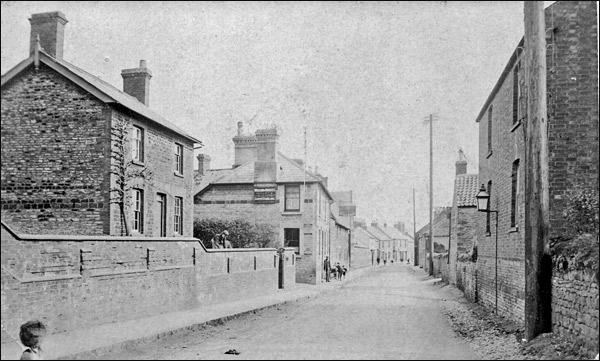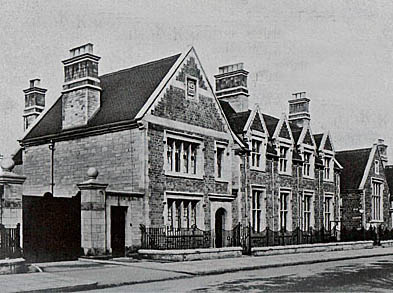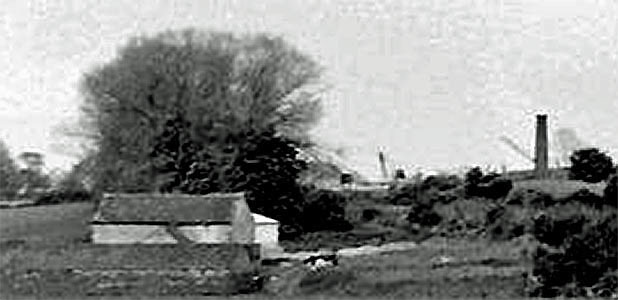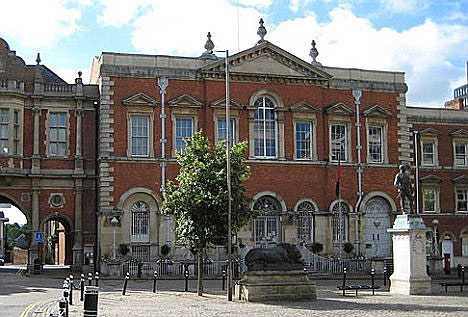John Meads 2014 |
||||||
|
||||||
|
||||||
|
Northampton Mercury Saturday, 19 March 1881 Charge of Incendiarism at Burton Latimer Harry Mason, Burton Latimer, was charged with setting fire to two straw stacks, the property of Mr Eli Eady, at Burton Latimer, on 5th March. Mr Heygate, of Wellingborough, defended. Prosecutor said he occupied a field near to the village of Burton Latimer, in which were two stacks of straw, which stood near the road in line with the centre of the field. They contained about 40 tons of straw. There were no buildings near. On the night of 5th March last they were destroyed by fire. The corn had been threshed in the field, and the barley chaff was taken away, but the oat chaff left near the stacks. - By Mr Heygate: Prisoner had never worked for witness. He was a stranger to him. John Herbert, son of a farmer, of Burton Latimer, said he lived at a lodge near what was called the 40 Acre-road. On Saturday night, 5th March, he left Burton at 9 o’clock in the evening, and passed Mr Eady's field on his way home about a quarter past nine. The straw stacks were all safe then. George Whittering, labourer, Burton Latimer, said he worked at the Ironstone Works, Cranford where prisoner also worked. On the fifth instant they were both working in the same pit. Prisoner left his work at about half past three in the afternoon. Witness left afterwards, and caught him up on the way from Cranford to Burton. They went by the road to Burton together. They then went to the Thatchers Arms public house. Witness went home, and had his tea, and in the evening joined him again at the Duke’s Arms, where they remained until a quarter to nine. They afterwards went to another public house, where they remained until ten o’clock. Prisoner then left witness and some of the men whom they had been drinking with. Prisoner left them at the top of Bakehouse Lane. Witness saw nothing more of him that night. It was then raining fast. About twenty minutes to eleven witness heard an alarm of fire. Saw prisoner next morning at his home. He had a cigar and a box of fusees#. Witness asked him where he got them from, and he replied, “Moore’s. “ On the following Wednesday he said he got the fusees from Newman’s. The fusees were similar to those produced. - Cross-examined by Mr Heygate: Prisoner had had plenty to drink on the evening in question. He was drunk from six until ten. Did not see him fall down when he came out of the public house. - George Ball Smart, shepherd to Mr Walker, of Burton Latimer, said the cottage where he lived was opposite Lewis’s public house. On the night of 5th March, about twenty five minutes past ten, he went from his cottage to his master’s house. He went down Bakehouse-lane, up past the Post Office, up to Mr Walker’s yard where he remained between five and ten minutes. When he returned into the street he saw the light from a fire in the direction of Mr Eli Eady's field, or Mr Walker’s lodge, which was in the same direction. Witness gave the alarm at Mr Walker’s house. As he was returning he met the prisoner coming from the direction of the fire. He was coming down the street. By Mr Heygate: Into Burton? Witness: "Yes." Examination resumed: He was coming from the direction of the Cranford turn. He was walking sharp. Witness asked him where the fire was. He said “ ***** the fire. Is there one? I have never seen it.” Witness drew his attention to the light, and asked prisoner where he had come from as he had not seen it. He said" Cranford." Witness asked prisoner if he would go back with him to the fire. He said he would not go unless he could have a stick. Witness went to look for a stick, but could not find one. He then went to Walton’s window, and called “Fire”, and Mr Walton and witness went off together. Did not see any more of the prisoner. Witness was the first to arrive at the fire. The stacks were burning at one end and just round the corner. - William Downing, baker, Burton Latimer, stated that on the evening in question he was driving from Addington to Burton, where he arrived at 20 minutes to eleven. When he got over the railway bridge he saw a fire in the direction of Mr Eady's stacks. It was then small. It afterwards blazed up. Could see straight to Mr Eady’s fields. He drove straight into the village. The first person he saw was Smart, the shepherd. He was near Mr Walker’s gates, and gave the alarm of fire as he went past. He saw two men 11/2 miles before he got to the village. Henry Stokes, lamplighter, Burton, having given evidence corroborative of former witnesses, P.C. Passmore, stationed at Burton, said he was on duty on the fifth inst. He saw a fire about twenty minutes to eleven pm in the direction of Forty-acre field. He went at once to it across the field. He saw Mr Walker and the shepherd. Then the stacks were in flames. On the following morning he went to prisoner’s house, and asked for his boots (produced). They were wet and covered with oat husks. Asked him where he had been. He said “Up Cranford road.” He asked him what he had been there for. He said he did not know. Asked him if he had been to the fire. He said, “No”. In his pockets there was a box of fusees. Asked where he had them from. He said, “Mr Newman’s.” Witness did not see a knife or a cigar. On the following Wednesday he told him he went up the Cranford road to see where the fire was. He took the boots to the scene of the fire on Sunday to see if they had made any impression, but could not see any footprints. - Detective Inspector Swain said on the 9th inst. he went to Burton Latimer to make enquiries respecting the fire. He took a number of statements, amongst others that on the prisoner. He was not then charged with this offence. He cautioned him. He then made a long statement. - Without calling on Mr Heygate, the Bench, after an adjournment for consideration, dismissed the case. Leicester Chronicle Saturday 16th April 1881
The Trial At the Northampton, Bedford and Buckingham Spring Assizes held at Aylesbury on Wednesday 27th April 1881 Harry Mason appeared before a Grand Jury and subsequently before Mr. Justice Lopes. The Northampton Mercury of Saturday 30th April reported the trial thus: Alleged Incendiaries at Cranford – Harry Mason (19), labourer, was indicted for feloniously setting fire to a stack of corn and a stack of straw, the property of John William Briggs, at Cranford St. John, on 2nd April.– Mr Bennett prosecuted; Mr Lloyd defended the prisoner.– Mr Bennett having opened the case, and produced a plan of the neighbourhood in which the stacks were situated, called the prosecutor, a farmer, of Cranford, who said on 2nd April the men employed at the Cranford Iron Ore Company’s works had a dinner together in a barn on his premises . In a field near the barn were two ricks, one of corn and the other of straw, and these were both destroyed by fire on the night of the dinner. The stacks were worth £25. – William Mansbridge, manager to the Cranford Iron Ore Company, stated that the prisoner was one of the men whom partook of dinner in Mr Briggs barn. Witness was standing about four yards from the door of the barn, when he heard footsteps coming from the direction of the stacks. The person passed witness, and he then saw that it was the prisoner Mason. A few seconds afterwards witness saw the stacks on fire. He raised an alarm, and, having fetched of the police, returned to the barn, where he found Mason sitting on the stall, smoking his pipe. He rose when he saw witness, in the course of some conversation he (witness) reminded him that he was the last man to go into the barn. Prisoner made no reply, and when charged by the constable he said, “I am sure I am innocent.” – Cross examined: Other men might have left the barn besides the prisoner. – William Braybrook said he was at Cranford on the night in question. Saw the prisoner leave the barn first with four or five men, with whom he returned, and afterwards by himself .– Cross-examined: A number of men were smoking about the premises during the evening.– Thomas Toseland, labourer of Grafton Underwood, was also at the dinner on the evening in question. Saw the prisoner come into the barn about a quarter past eight o’clock by himself, and almost immediately afterwards witness heard a cry of fire. –P.C. Currin, stationed at Cranford, was called to the fire, and from information received apprehended the prisoner on suspicion. Witness asked him when he went out of the barn last. He said, ‘is I have only been out of the barn once since dinner, and then I went out with three or four others. Witness then charged him with setting fire to the stacks. Prisoner and said, “You never saw me. How could I set fire to them when I was sitting here when they shouted fire.” Prisoner also said he had no matches upon him. Witness then took him into custody. Prisoner became very violent, and tried to get away. At the police station witness searched the prisoner, and in his pocket found three matches, a pipe, and some tobacco.– His Lordship thought there was no evidence to go to the Jury, and directed a verdict of "Not guilty" to be returned. He was surprised the bill was not thrown out by the Grand Jury, and if the prisoner had been found guilty on this evidence he should not be satisfied. – Prisoner was then discharged. Harry died in Kettering Workhouse, aged 42, in 1904. He does not appear to have married. His address was given as Croxen's Yard, Burton Latimer |
||||||



